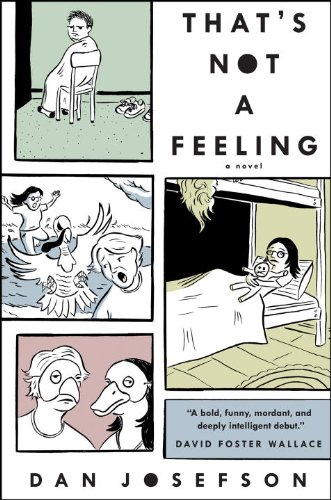Dan Josefson’s novel That’s Not a Feeling was a NYT Editors’ Choice and was selected as one of Booklist’s best books of 2012. He is the winner of a 2015 Whiting Award in Fiction and has received a Fulbright research grant. Josefson has an MFA from the University of Nevada, Las Vegas and lives in New York City.

-
That's Not A FeelingA Novel
“This was when my dad was still living with us, but he would come to services from work, so when we went home afterward I’d have to choose who to go home with. I don’t know if it upset my dad, but I always went home with my mom. Mostly because she drove the Beetle, which was so much more fun. She would play these old Patti Smith cassettes, and I’d sing with her. But the best part was she’d let me put on the dome light, so it felt like we were in this little space capsule, just the two of us. That’s my favorite memory, me and my mom going home from temple Friday nights. That car was like a lit-up igloo rolling through the dark.”
 That's Not A Feeling : A Novel
That's Not A Feeling : A Novel -
That's Not A FeelingA Novel
When I heard the washing machine finish, I put our things in the dryer and went back to roaming the house. About fifteen minutes had passed before I realized that I’d forgotten to add the fabric softener. But when I went to put it in, there was an older woman standing in the back doorway, staring at the machine. She looked up.
It was the woman from the picture upstairs. I could tell, although she was older. Her face had changed. It continued to change as I stood there.
“I’ll call the police,” she said.
I was overwhelmed by pity. This woman was an adult, she probably owned the house, but seemed so scared. I knew I should run, but I was curious about this feeling. It wasn’t unpleasant. Somehow I felt okay as long as I kept her from entering the house, her house.
 That's Not A Feeling : A Novel
That's Not A Feeling : A Novel -
That's Not A FeelingA Novel
The walls of the Classroom Building were cracked down to their foundations, and the rooms scattered with fallen acoustic tiles; the ceiling’s grid of aluminum beams held only fire alarms whose frayed wires wound into space. The linoleum floor tiles in the atrium were warped and uneven. And among the yellowed paperbacks and brittle hardcover books in the Teacher’s Lounge, I found that strange notebook with the teachers’ speculations about which of us might grow up to be killers.
 That's Not A Feeling : A Novel
That's Not A Feeling : A Novel
“Metaphor is a hell of a weapon in Dan Josefson’s debut, That’s Not a Feeling . . . a troubled-young-folks-away-at-school novel more bright, dark, and hilarious than any half-dozen first novels all smooshed together . . . The result is a funny, humane, egalitarian, and gently challenging book, one to quote and roar over, and one that gets better and stranger as it goes.” —Alan Scherstuhl, The Village Voice
“Josefson’s deft, tempered prose style . . . supplies a measure of traction. It’s unornamented but never flat or blunted, so that the characters, not the sentences, heat the pages. Aubrey and Tidbit provide the most heat, albeit radioactive, and the novel attains a particularly sublime warmth when Tidbit and Benjamin engineer an escape from the school that involves sinking a rowboat in the middle of a nearby lake.” —Jonathan Miles, The New York Times [on That’s Not a Feeling]
“This remarkable first novel focuses on an autumn spent by 16-year-old Benjamin at an unorthodox upstate New York school for troubled teens . . . Funny at times, and more than a little sad, the book’s form perfectly mirrors Benjamin’s profound sense of dislocation and uncertainty. This is a powerful, haunting look at the alternate universe of an unusual therapeutic community.” —Library Journal, starred review [on That’s Not a Feeling]
“Dan Josefson is a writer of astounding promise and That's Not a Feeling is a bold, funny, mordant, and deeply intelligent debut. ” —David Foster Wallace
Dan Josefson’s novel That's Not a Feeling is funny, original, and wise, marked by an unflashy but perfectly pitched absurdity. Despite its title, it manages to delve into the complex feelings of both the children and the adults in the experimental school where the story is set. With its nuanced characterizations, its compassion, lyricism and curiosity, it reminded the judges of William Maxwell, particularly in its exquisite sense of place.